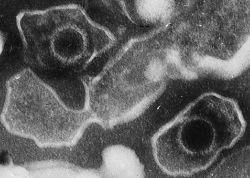Difference between revisions of "Template: Popular article 05 13" - New World Encyclopedia
From New World Encyclopedia
(Daily popular article 2009 24) |
|||
| (2 intermediate revisions by the same user not shown) | |||
| Line 1: | Line 1: | ||
{{Main page article box| | {{Main page article box| | ||
type=Popular| | type=Popular| | ||
| − | title= | + | title=Epstein-Barr virus| |
| − | image_name= | + | image_name=Epstein Barr Virus virions EM 10.1371 journal.pbio.0030430.g001-L.JPG| |
| − | image_desc= | + | image_desc=Two Epstein-Barr virions| |
| − | text= | + | text='''Epstein-Barr virus,''' frequently referred to as '''EBV,''' is a distinct member of the [[herpesviridae|herpesvirus family]] (Herpesviridae) of [[DNA]] [[virus]]es and one of the most common viruses in [[human]]s. It is also known as '''Human herpesvirus 4''' (HHV-4). Most people become infected with EBV, which is often [[asymptomatic]] but commonly is associated with acute [[infectious mononucleosis]], as well as certain types of [[cancer]], such as nasopharyngeal carcinoma and Burkitt's lymphoma. EBV is so ubiquitous among humans worldwide that it is difficult to tell if it is the causal agent of the various associated diseases or simply present. |
| − | + | }} | |
| − | |||
Latest revision as of 15:13, 15 April 2022
Popular Article: Epstein-Barr virus
Epstein-Barr virus, frequently referred to as EBV, is a distinct member of the herpesvirus family (Herpesviridae) of DNA viruses and one of the most common viruses in humans. It is also known as Human herpesvirus 4 (HHV-4). Most people become infected with EBV, which is often asymptomatic but commonly is associated with acute infectious mononucleosis, as well as certain types of cancer, such as nasopharyngeal carcinoma and Burkitt's lymphoma. EBV is so ubiquitous among humans worldwide that it is difficult to tell if it is the causal agent of the various associated diseases or simply present.
